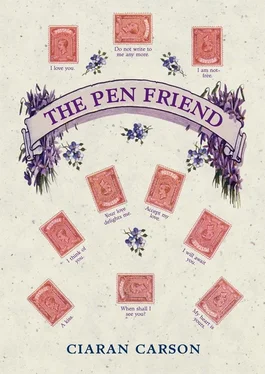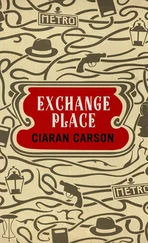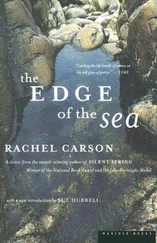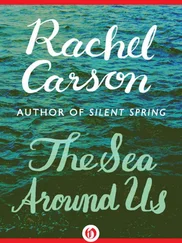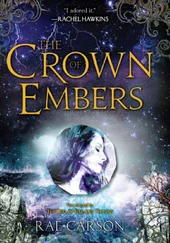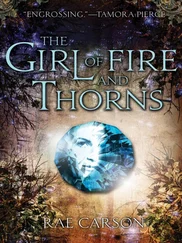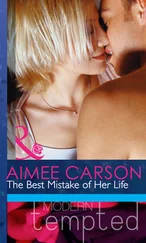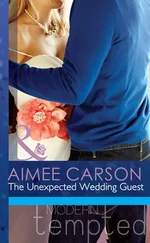So there I was staring out the window one day, you said, I’d been there about a month, and Callaghan comes in, he’s the boss of the outfit, if you could say there was a boss, because everyone seemed to be doing their own thing. At least, he was the person who recruited me. Recruited? I said. Well, of course we all had to go through the motions of an interview process, the jobs were advertised, and all that, though not very well. Anyway, I was recruited, if that’s what you call falling into conversation with a man in a hotel bar who ends up telling you you’re perfectly cut out for a job in his firm, you said, and you think nothing more of it till a few days later he gives you the call, like he said, that you thought he wouldn’t. So Callaghan comes in and says, We feel it’s about time you made your differentiation. Differentiation? you said. Yes, says Callaghan, we let people find their feet for about a month or so, and then they do their differentiation. Ask Tony Lambe how it’s done, he’ll put you right. Tony Lambe? I said, the guy we met at the City Hall that day? When I found out you were called Miranda? Yes, you said, and you had the grace to blush a little. Baa Lambe’s one of you? And how many are you, exactly? Oh, there’s quite a few of us, you said, I’ll get round to that in a while.
So anyway, what’s this differentiation business all about? I said to Tony Lambe. Oh, it’s just another name for project management, forward work plan, whatever you want to call it, says Tony. You differentiate between what you want to do, and what you don’t want to do. And what do you do? I asked Tony. Oh, basically, I’m in menswear, I sell ties, he says. Ties? I said. Yes, you know, neckwear, says Tony, ties, cravats, you know I’m a bit of neckwear freak, Miranda. And this has been a great opportunity for me, developing my own brand of ties. Lavelle & Smyth? Well, maybe you haven’t heard of us, we’re very discreet, says Tony, but I can assure you a lot of the top people are wearing Lavelle & Smyth ties. Our Irish poplin line is doing very well. Poplin, the Pope’s linen, though we don’t advertise the etymology, says Tony, but really, a lovely material for ties, nice ecclesiastical feel to it, pure silk on the outside, woollen worsted yarn on the inside, you get the best of both worlds, the sheen of the silk and the elasticity of the wool, a poplin tie keeps its shape wonderfully. Then we’ve got a lovely line in Japanese handwoven silk, said Tony.
As you know, I wasn’t much into expensive ties then, Nina, not on my salary, I tended to buy the few I wore in charity shops, or in the Friday Market, ties from the Forties and Fifties, but I did know Lavelle & Smyth’s shop in Crown Entry, and had sometimes paused before its window to admire its many-coloured display, ties in coral and apple-green and lavender and faint orange, ties in needle stripes and pinstripes and wide stripes, and ties with diamonds and gleaming lozenges, and delicate pink flowers on a deep blue ground, and peacock’s eyes set amid glowing russet silk, they were really beautiful if unaffordable ties, and I marvelled that Tony Lambe should be their commissioner, Baa Lambe who when I knew him had hardly an eye in his head for such things, but then I suppose people change, or are changed, or can be made to change.
Anyway, you said, Tony explained this differentiation thing. Essentially you just draw up what you want to do, a business plan, cost it all out, give them a budget, he said. I’ve never known them to turn one down. Once you’re recruited, you stay recruited, says Tony, they’ll give you what you ask for, and more, they’ll disburse a little of their largesse. Compared to the millions they spend on Northern Ireland, it’s pin money. And what do they get out of it? you asked. Well, you have to file a report once every so often, customer profiles, that kind of thing, nothing that you wouldn’t be doing anyway, says Tony. They’re not too demanding, they’re happy if you’re happy. The main thing is to get to know your clients, find your niche. And what’s your niche, Nina? I asked. Interior design, corporate events styling, that kind of thing, you said. And have I heard of you? I said. Oh, probably not, you said, I’m Fawcett & Jones, they like us to have those kind of joint-venture names, gives an impression of class. Or music-hall double-acts, I said, like Conway & Stewart? Yes, you said, like Smith & Wesson. And you toyed with the Conway Stewart Dinkie that hung from the mauve silk lanyard about your neck.
I didn’t have to think twice about which pen to write this with, for it arrived in the post together with your card. It was an eBay item I’d been expecting for some days, and to tell you the truth I barely glanced at your card before attacking the package. I took a box-cutter to the layers of parcel tape, slicing through them with some difficulty before I could open the cardboard box which spilled a good few of its white polystyrene packing beans among whose remnants I discovered a section of plastic piping, taped at both ends, which contained, swaddled in kitchen roll, the pen. I wish you were here now to see it, for the red and black marbled wood-grain effect of its body would remind you of your Dinkie. This is a Swan, made in England in the 1920s by Mabie Todd and Co., and it’s got a stylised swan engraved on the barrel and a white swan in intaglio on the top of the cap. At five and a half inches capped, and seven inches with the cap posted, it’s a longer pen than most, slender, elegant, dignified. It was made without a pocket clip, perhaps to sit impressively on the desk of a person of discernment. I took it out to the better light of the back garden and I was holding it up to let the sun play on it, turning it this way and that to admire the patterning, when two swans — a pen and a cob — flew overhead honking mournfully to each other, and I knew then that I was obliged to write this letter with the Swan.
I watched the swans till they were out of sight, thinking of the story of the Children of Lir, who were turned into four swans by their jealous stepmother. My father had often told it to me as a child, and I can hear the slow-quick-slow narrative pulse of his voice, and I see in my mind’s eye again the snow softly falling on the grey waters of the Sea of Moyle as the Children of Lir flew between Rathlin and Erin, uttering their mournful songs, for they still retained their human voices. And I wondered why a female swan should be called a pen, when it was from the wings of geese that one commonly obtained feathers for quills. My father, indeed, had shown me how to make a quill pen when I was in my teens, and how to make the oak-gall ink used by the medieval Irish scribes.
The oak-gall, or the oak-apple, is an excrescence formed on some species of oak by the larvae of gall-wasps, the females of which lay their eggs in punctures made into the bark. As the larvae grow, the gall develops and forms a home for them, until they finally eat their way out. To make ink, you grind the tannin-rich oak-galls, and add water, ferrous sulphate and gum arabic; and the whole process, from wasp to ink, as my father explained, was a symbol of the transformation of the soul through writing. A wasp is an inverted bee, he said, and as the bee represents the Virgin Mary, and goodness, so the wasp means evil. The wasp, unlike the bee which spreads good by pollinating, merely scavenges and lays its eggs. But the oak tree where it lays its eggs is the sacred tree of the Druids, a repository of deep and aged wisdom, said my father. So when the wasp lays its eggs in the tree, the tree winds its fibres of wisdom around them to protect itself, and thus evil is transformed into good.
He showed me how to grind the oak-galls. Slowly, slowly, he said, use your whole arm, not just the wrist, and relax, take your time, imagine you’re saying a rosary, breathe steadily, for you’re putting your whole body into it. Now add the water. Remember that water is life, the life of the spirit. Now add the ferrous sulphate, he said, and as I did so, I watched the thick brown mud of the ground oak-galls turn magically black. Ferrous sulphate, that’s iron and sulphur mixed. The alchemists used sulphur in their quest for making gold, said my father, but they did not realise that the real gold is God’s word, which is spread by this ink we’re making now. Now the gum arabic, that’s a binder, it binds the body of the ink to its soul, and it binds it to the parchment. Well, of course we must make do with paper. And he would get me to transcribe a few verses of the Bible with the quill pen and the oak-gall ink.
Читать дальше
